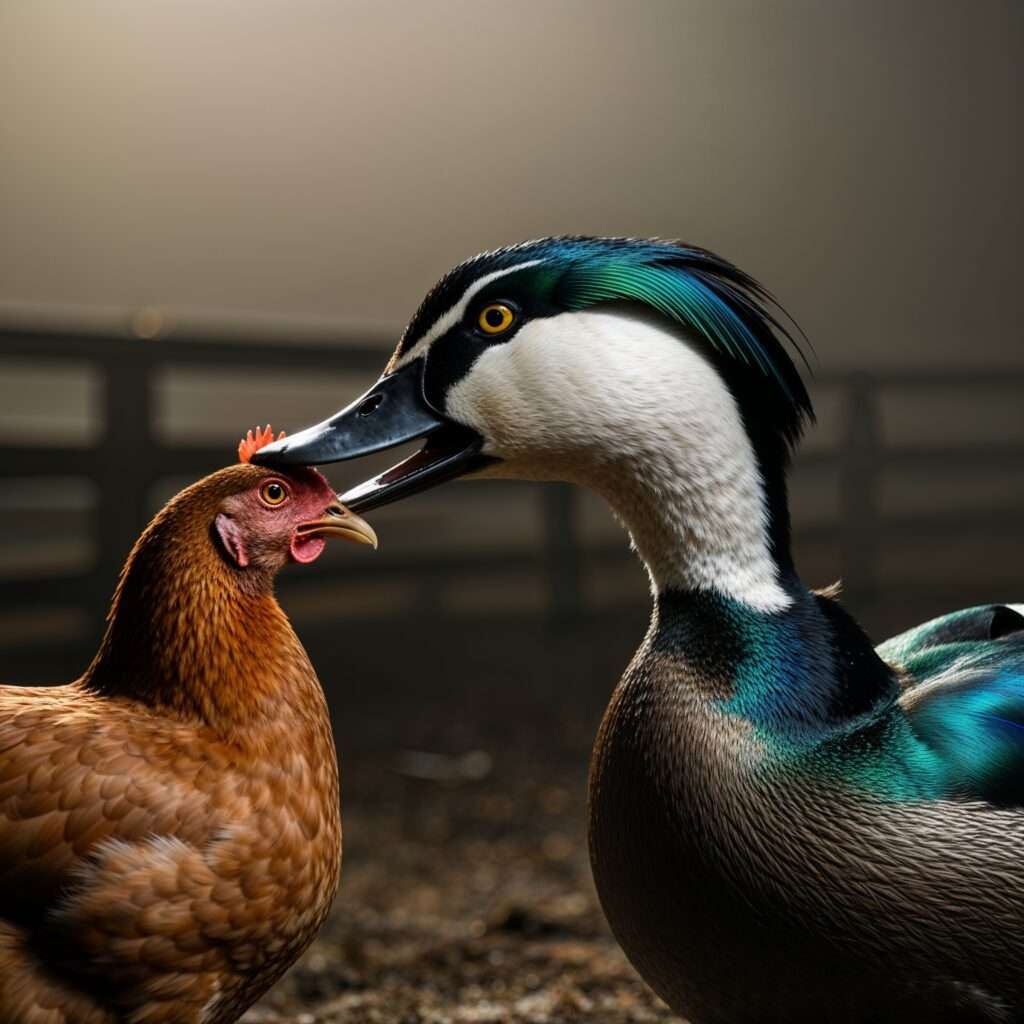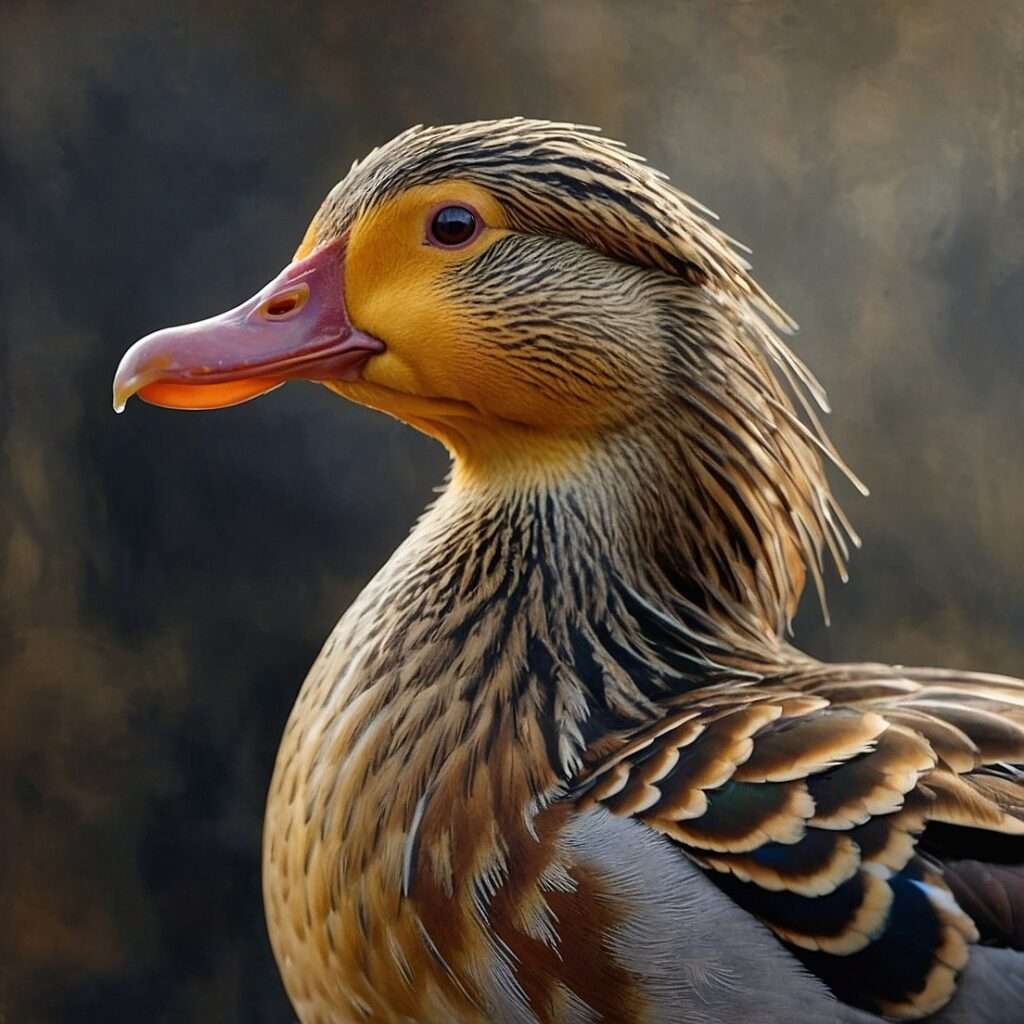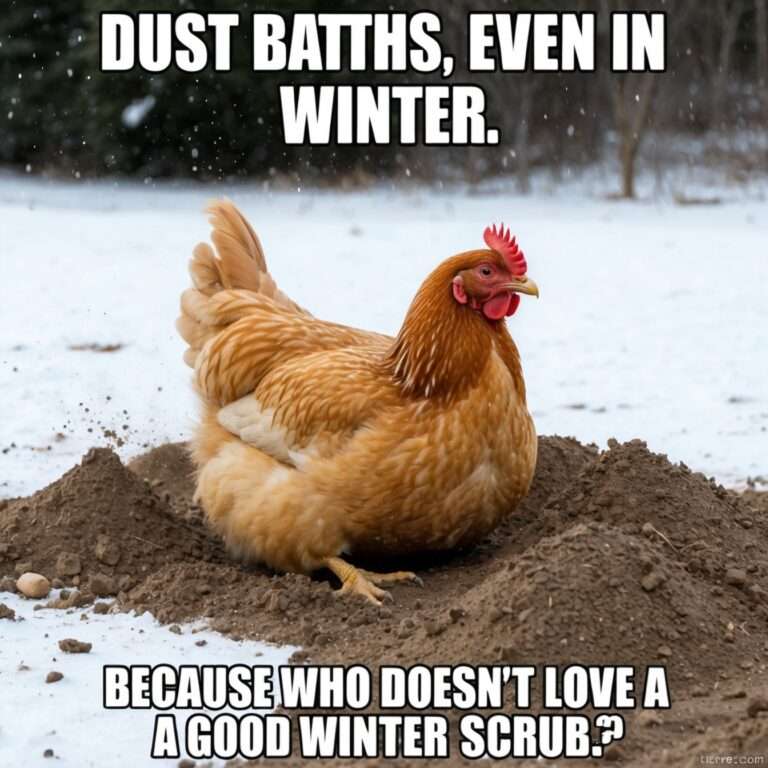
A close-up of a drake gently interacting with a chicken, highlighting flock dynamics in a natural environment.
If you’ve recently added a male duck (drake) to your mixed flock, you may have done so on purpose to benefit your female ducks. However, like many backyard flock owners, you might also have ended up with a drake by accident—perhaps unknowingly purchasing a male when you thought you were getting all females. Since male ducks are often indistinguishable from females until they mature, you may not realize you have a drake until his behavior begins to change, sometimes bringing challenges to the flock dynamic. Drakes and chickens in a mixed flock can bring humorous memories, or horrific ones, here we will discuss the risks and options available.
Whether intentional or accidental, managing drakes and chickens in a mixed flock requires understanding the risks and taking steps to protect your chickens, especially the hens. This guide explores the challenges of keeping drakes and chickens together, effective strategies for managing a mixed flock, and tips to ensure the safety and well-being of all your birds.
Challenges of Managing Drakes in a Mixed Flock
1. Aggressive Mating Behavior
Drakes may display aggressive mating behavior, which can be dangerous for chickens due to the anatomical differences between the two species.
- Risks:
- A drake attempting to mate with a hen can cause severe injuries, including broken bones or internal damage.
- Such behavior is more common during mating season, making vigilance especially important during this time.
2. Territorial Aggression
Drakes can become territorial during mating season, not only towards other drakes but also towards chickens.
- Effects:
- Chasing, pecking, and fights may occur, leading to stress and injury in the flock.
- Stress can lower egg production and compromise the health of both ducks and chickens.
3. Overmating Female Ducks
If a drake doesn’t have enough female ducks in the flock, he may overmate the available females, leading to:
- Feather loss
- Stress and exhaustion
- Potential injuries
Solution: Maintain a ratio of at least 3-4 female ducks per drake to distribute mating pressure.

Risks to Chickens
1. Anatomical Differences
Drakes and chickens have significant reproductive differences. Drakes have a phallus, unlike roosters, which makes mating attempts on hens dangerous and potentially life-threatening.
2. Injury Risks to Hens
Drakes are often larger and stronger than hens, which increases the likelihood of harm during mating attempts.
- Common Injuries:
- Bruises and cuts
- Broken bones
- Internal trauma
3. Psychological Stress
Frequent harassment or aggression from a drake can cause hens to hide, avoid eating, or stop laying eggs altogether.
Managing Drakes in a Mixed Flock
1. Provide Separate Spaces
To minimize risks, consider separating chickens and ducks, particularly during mating season.
- Use partitions within the coop or create separate runs to prevent interaction when needed.
- Allow supervised mingling only in larger spaces where hens can avoid unwanted attention from the drake.
2. Monitor Flock Dynamics
Regular observation is key to spotting problems early.
- Signs to Watch For:
- Injured hens or missing feathers
- Aggressive chasing or pecking behavior
- Hens isolating themselves or avoiding the drake
- Take immediate action if aggressive behavior is observed, such as separating the drake temporarily.
3. Ensure Adequate Female Ducks
A proper male-to-female ratio reduces the risk of overmating and aggression toward chickens.
- Ideal Ratio: At least 3-4 female ducks per drake.
4. Provide Enrichment and Space
Drakes can become aggressive if they feel crowded or bored.
- Ideas for Enrichment:
- Provide a pond or kiddie pool for swimming.
- Create foraging areas with fresh grass or plants.
- Add logs, platforms, or other elements for climbing and exploring.
- Space Requirements: Ensure the flock has plenty of room to roam, with at least 15 square feet per bird in an outdoor run.
5. Consider Removing the Drake
If aggression or injuries persist despite your efforts, it may be best to remove the drake from the mixed flock.
- House the drake with other ducks only.
- Alternatively, rehome the drake to ensure the safety of your chickens.
Signs of Trouble to Watch For
1. Injured or Stressed Hens
- Hens hiding, avoiding the flock, or showing signs of injury (e.g., limping, missing feathers, cuts).
- Immediate separation and care are necessary to prevent further harm.
2. Aggressive Behavior
- Watch for signs of the drake chasing, pecking, or mounting hens.
- Address aggression promptly with separation or increased space.
Additional Considerations for Mixed Flocks
1. Seasonal Adjustments
- During mating season (especially spring), aggression and mating behaviors increase.
- Temporary adjustments, such as separating males or increasing space, can help prevent conflicts.
2. Health Checks
- Injuries from aggressive behavior can lead to infections if untreated.
- Perform regular health checks on both chickens and ducks, and consult a vet if needed.
3. Feeding Considerations
- Chickens and ducks have slightly different dietary needs.
- Ducks require more niacin, which can be added through supplements or duck-specific feed.
- Ensure separate feeders or access to species-specific feed to prevent competition.
4. Proper Shelter
- Ducks prefer open, well-ventilated spaces, while chickens need roosting bars and nesting boxes.
- Providing appropriate shelter for each species can reduce stress and improve overall flock harmony.
Conclusion
Managing drakes and chickens in a mixed flock requires careful planning and observation to ensure the safety and well-being of all birds. By addressing challenges like aggressive behavior, anatomical risks, and overcrowding, you can create a harmonious environment where chickens and ducks thrive together. Remember to monitor flock dynamics, provide adequate space and enrichment, and take proactive steps during mating season. With proper care, a mixed flock can be a rewarding addition to your backyard.

Further Reading on Paranoid Prophet
- Mixed Flock Care: Chickens and Ducks
This article provides an in-depth guide on raising chickens and ducks together in a mixed flock. It covers essential topics such as housing, feeding, and managing behavior to ensure a safe and harmonious environment for both species. - Planting a Memorial for Chickens or Ducks
A thoughtful guide to creating a memorial for a beloved chicken or duck, offering tips on selecting meaningful plants, choosing the right location, and crafting a peaceful tribute to honor lost flock members. - What Not to Feed Chickens: Common Mistakes and Hidden Dangers
This resource outlines foods and substances that are harmful to chickens, including toxic plants, processed foods, and household scraps. It provides practical advice on avoiding common mistakes to keep your flock safe and healthy.
These resources offer valuable insights into mixed flock care, meaningful memorials for flock members, and safe feeding practices to ensure the well-being of your chickens and ducks.
SOURCES
- Managing a mixed flock of drakes and chickens requires careful attention to prevent aggressive behaviors and ensure the well-being of all birds. The following sources provide valuable insights and strategies for effectively managing such flocks:
- “Drake Mating/Attacking My Hens” – BackYard Chickens
This discussion highlights the dangers of drakes attempting to mate with hens, emphasizing the importance of separating drakes from chickens to prevent serious injuries. Backyard Chickens - “Aggressive Ducks: Why Drakes Attack and How to Permanently Stop Aggression” – Raising Ducks
This article explores the causes of drake aggression, including dominance and mating behaviors, and offers methods to curb such aggression, such as isolation during mating season and ensuring an appropriate male-to-female ratio. Raising Ducks - “5 Ways to Deal With Extra Drakes” – Raising Ducks
This resource discusses managing multiple drakes, recommending a ratio of at least four females per drake to prevent overmating and aggression, and suggests options like creating separate bachelor groups. Raising Ducks - “Why I Will Never Keep a Drake in My Mixed Backyard Flock” – Home in the Finger Lakes
This personal account details the challenges of keeping drakes with chickens, particularly the risks of drakes attempting to mate with hens, which can lead to severe injuries or fatalities. Home in the Finger Lakes - “Aggressive Drakes – Reasons & Solutions” – LearnPoultry
This article examines factors contributing to drake aggression, such as mating season and territoriality, and suggests solutions like providing adequate space and separating aggressive drakes to maintain flock harmony. Learn Poultry - These sources offer comprehensive guidance on managing drakes within mixed flocks, emphasizing the importance of appropriate ratios, monitoring behaviors, and implementing separation strategies when necessary to ensure the safety and health of all poultry.
FAQ: Managing Drakes and Chickens in a Mixed Flock
General Questions
1. Why is managing a drake in a mixed flock challenging?
Drakes can exhibit aggressive behavior, particularly during mating season. Their attempts to mate with hens can cause injuries due to anatomical differences, and they may also show territorial aggression toward chickens or other drakes.
2. Can I keep a drake and chickens together?
Yes, but it requires careful management. Providing enough space, maintaining proper male-to-female ratios, and monitoring behavior are crucial for keeping a drake and chickens together safely.
3. How do I know if I accidentally bought a drake?
Drakes are often hard to distinguish from females as ducklings. As they mature, signs like larger size, curled tail feathers (in some breeds), and a raspy quack can indicate you have a drake.
Behavior and Risks
4. What are the risks of a drake mating with a hen?
Drakes can seriously injure hens due to their different reproductive anatomy. Injuries may include broken bones, internal trauma, or even death.
5. Why is my drake attacking my chickens?
Drakes may become territorial or aggressive during mating season. Overcrowding, boredom, or lack of female ducks can also trigger aggressive behavior.
6. How can I tell if my hens are stressed?
Stressed hens may exhibit signs like hiding, avoiding the flock, reduced egg production, or visible injuries such as missing feathers or cuts.
Prevention and Solutions
7. How many female ducks should I have per drake?
To prevent overmating, aim for at least 3-4 female ducks per drake. This ratio helps distribute the drake’s attention and reduces aggression toward chickens.
8. What should I do if my drake is aggressive?
Consider separating the drake during mating season or increasing the flock’s space and enrichment. If aggression persists, housing the drake with ducks only or rehoming him may be necessary.
9. Can I prevent a drake from mating with hens?
Separating chickens and ducks, particularly during mating season, is the most effective way to prevent drakes from attempting to mate with hens. Use partitions or separate runs for added safety.
Care and Maintenance
10. Do drakes and chickens need different feed?
Yes, ducks require more niacin than chickens. Ensure ducks have access to a niacin supplement or feed formulated specifically for ducks.
11. How much space does a mixed flock need?
Provide at least 15 square feet of outdoor space per bird to reduce stress and aggression. Enrichment, such as foraging areas and ponds for ducks, can also help maintain harmony.
12. How can I ensure my flock’s health in a mixed setup?
Perform regular health checks for signs of injury or illness. Clean the coop and run frequently, and provide species-specific shelters, such as roosting bars for chickens and open spaces for ducks.
Seasonal Considerations
13. Is aggression worse during certain seasons?
Yes, mating season (typically in spring) is when aggression and mating behavior are most pronounced. Temporarily separating the flock during this time can reduce conflicts.
14. Should I make seasonal adjustments to housing?
Yes. In winter, ensure ducks have well-ventilated shelter and chickens have dry, warm spaces. In summer, provide shaded areas and water sources to prevent overheating.
What If It’s Too Difficult?
15. What should I do if managing a drake becomes too challenging?
If hens are frequently injured or the drake’s behavior disrupts the flock, consider removing the drake. He can be housed with ducks only or rehomed to ensure the safety of your chickens.


